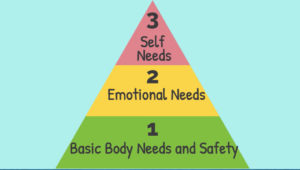Most parents think meltdowns should only happen during toddlerhood, and – if they last past toddlerhood – they should end by late childhood. Just so we’re on the same page, experts generally agree that toddlerhood happens between ages two and five, and childhood ends at around age twelve.
By the time adolescence arrives at age thirteen, most parents think something like this:
Shouldn’t temper tantrums be a thing of the past?
However, when it comes to parenting, one quickly learns that there’s no such thing as should.
According to Biosocial Theory – which informs Dialectical Behavior Therapy (DBT) – every child is born with a different emotional temperament. Children in the same family can have naturally different sensitivities and reactivity levels. That means that your oldest child may be emotionally reactive, while your second or third might be chilled-out and laid-back. Although most people – professionals included – think parents do influence their children’s temperament, it’s important to understand that kids are the way they are through no fault or choice of their own: that’s how they were born.
Meltdowns in Adolescence
In practical terms, that means that for some children, meltdowns will persist through adolescence. These children are born with high emotional sensitivity and reactivity. In addition to being highly emotional and reactive, these children may also take longer than other children to return to their relatively undisturbed, baseline state. Adolescents with issues such as attention-deficit/hyperactivity disorder (ADHD), autism spectrum disorder, oppositional/defiant disorder (ODD), disruptive mood dysregulation disorder (DMDD), conduct disorders, sensory processing disorder, or other behavioral issues are more likely to have meltdowns than adolescent without similar diagnoses.
Although it can be very frustrating and stressful to manage a temper tantrum while it’s happening, there are strategies parents can learn to predict meltdowns and reduce their frequency.
What is a Meltdown?
First, though, we have to understand what a meltdown is. This isn’t the two-second yelling, crying, and/or door slamming that happens when your adolescent doesn’t get what they want. A true meltdown or temper tantrum lasts much longer than just a few seconds. It can be triggered by issues that seem minor to those watching from the outside. And it can escalate in intensity over time.
Dr. Ilyssa Bass, PhD, an expert on child and adolescent behavioral issues who holds degrees from Stanford University, Oxford University, and the University of California–Santa Barbara, compares a meltdown to a fever.
“The fever tells us there’s something wrong going on inside the body,” Bass says. “But the fever itself isn’t the problem.”
The real problem, she argues, is usually hidden.
A parent who focuses on the external behavior and gets angry about it only sees the tip of the iceberg, she says. To get to the source of the problem, one must look deeper.
What Triggers the Meltdown?
Dr. Bass says children and adolescents have three basic categories of needs, as seen in this graphic, which is a simplified version of Maslow’s Hierarchy of Needs.
.
When children with complex issues – which she calls hidden differences – act out, she advises parents to ask themselves if their child is struggling with one of the following unmet needs.
Hierarchy of Needs: A Checklist
- Basic Body Needs/Safety
- Food and water: Are they hungry or thirsty?
- Sleep: Did they sleep enough the night before?
- Temperature: Are they too hot or cold?
- Real or perceived safety issues: Do they feel safe?)
- Sensory issues: Are they sensitive to sound/light/motion/touch/taste? Children with sensory issues may often feel stressed if they’re in a room that’s too bright, one with too much noise, or one with too many people.
- Emotional Needs
-
- Connection & belonging: Do they feel like they belong somewhere?
- Friends: Do they feel connected to a social group or circle?
-
- Self Needs
- Skills: Do they have the skills to get through the basic school day?
- Mastery: Is there something they’re working on mastering? A sport, an instrument, a new subject in school, or something else?
- Esteem: Is there someone in their life who sees the good in them, and do they know that?
- Contribution: Do they feel, in any way, that they contribute or give to the family/community?
Of course, during a meltdown or tantrum it’s difficult for a parent to focus on anything other than what’s going on in that very moment. But Dr. Bass advises parents, either before or after the event, to try and figure out if it’s triggered by an unmet need. By looking closely to determine the source of the meltdown or tantrum, a parent can identify patterns in their child’s behavior.
“Over time, you can learn to predict meltdowns, know your child’s triggers, and know what may prevent them,” says Dr. Bass.
Now that you know what causes most meltdowns, you can find out what to do when they happen by reading our article ” What Do You Do in the Middle of an Adolescent Meltdown?“
When The Problem Is Extreme
Of course, sometimes all the detective work in the world won’t help if your child or adolescent has a behavioral disorder that requires major intervention by a mental health professional.
If you deal with meltdowns multiple times a day or multiple times a week, and they’ve been going on for six months or longer, your best option is to visit a licensed mental health professional so they can evaluate your child.
Based on the results of a clinical assessment, your child or teen may require professional support. Clinicians may recommend outpatient therapy, an intensive outpatient program (IOP), a partial hospitalization program (PHP), or even a residential treatment center (RTC). Sometimes, therapy is combined with a recommendation for Parent-Management Training. Clinicians may also recommend medication for your teen, if needed.































































